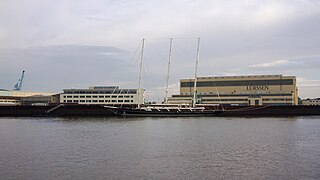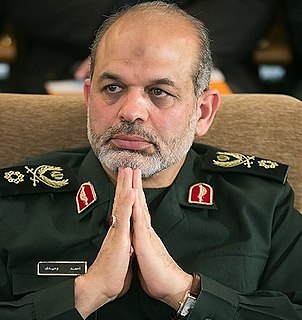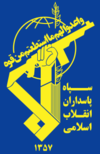Related Research Articles

Supercavitation is the use of a cavitation bubble to reduce skin friction drag on a submerged object and enable high speeds. Applications include torpedoes and propellers, but in theory, the technique could be extended to an entire underwater vessel.

A motorboat, speedboat or powerboat is a boat that is powered by an engine.

A missile boat or missile cutter is a small, fast warship armed with anti-ship missiles. Being smaller than other warships such as destroyers and frigates, missile boats are popular with nations interested in forming a navy at lower cost. They are similar in concept to the torpedo boats of World War II; in fact, the first missile boats were modified torpedo boats with the torpedo tubes replaced by missile tubes.

The Caldwell class was a class of six "flush deck" United States Navy destroyers built during World War I and shortly after. Four served as convoy escorts in the Atlantic; the other two were completed too late for wartime service. Two were scrapped during the 1930s, but four survived to serve throughout World War II, three of these in service with the Royal Navy under the Destroyers for Bases Agreement.

Lürssen is a German shipyard based in Bremen-Vegesack.

HMCS Bras d'Or was a hydrofoil that served in the Canadian Forces from 1968 to 1971. During sea trials in 1969, the vessel exceeded 63 knots, making her the fastest unarmed warship in the world at the time.
The Navy of the Islamic Revolutionary Guard Corps is the naval warfare service of the Islamic Revolutionary Guard Corps founded in 1985, and one of the two maritime forces of Iran parallel to the conventional Islamic Republic of Iran Navy. IRGC's Navy has steadily improved its capabilities to support unconventional warfare and defend Iran's offshore facilities, coastlines, and islands in the Persian Gulf.

INS Tabar (F44) is the third of the Talwar-class frigate of the Indian Navy. The frigate was commissioned on 19 April 2004 in Kaliningrad, Russia with Captain Biswajit Dasgupta. INS Tabar, a vessel in the Talwar class to be armed with supersonic BrahMos anti-ship cruise missiles. She is also equipped with Barak 1 missiles. The current Commanding Officer (CO) of Tabar is Capt Manav Sehgal.

In 1968 there was an incident when a Soviet November-class submarine tracked an American carrier group traveling at 31 knots (57 km/h). This led the United States Navy to develop the Los Angeles-class submarines, whose reported speed is 30–32 knots (56–59 km/h).

The Type 025 torpedo boat, also known as the Huchuan or Hu Chwan class, was once the backbone of the People's Liberation Army Navy (PLAN) in its confrontations with its much larger opponents in the Republic of China Navy. Although no longer serving in that capacity, this class is still active. While relatively unsophisticated, the class has enjoyed a longevity in active service thanks to a philosophy within PLAN which has continued to favor its use. Powered by Soviet-era engines, the hydrofoil-equipped boats are capable of 50 knots and carry two torpedo tubes for torpedoes, with some known to be armed with naval mines.

The Super Dvora Mark III-class patrol boat is the latest generation of the venerable Dvora family of fast patrol boats or fast attack craft (FPB/FAC). Manufactured by IAI Ramta in 2004 these vessels are capable of travelling up to 50 knots in littoral waters thanks to its state of the art thrust vectoring control Articulated Surface Drives (ASD) while holding various armaments, from automatic grenade launchers, AGM-114 Hellfire missiles, SPIKE NLOS missiles, and 30 mm cannons in its armory.

The Balilla class were the first submarines to be built for the Italian navy following the end of World War I. They were large ocean-going cruiser submarines designed to operate in the Indian Ocean based in Italy's East African colonies. The design was double-hulled and based on the German Type UE 2 U-boats, one of which, U-120 was supplied to the Italians as a war reparation. A 425 horsepower (317 kW) auxiliary diesel engine was installed as an extra generator.

Ahmad Vahidi is an Iranian military commander of the Revolutionary Guards. In 1988, he was appointed as the commander of its extraterritorial special forces, Quds Force. He was the minister of defense under Mahmoud Ahmadinejad, having held the post from 3 September 2009 until 15 August 2013. Vahidi is president of the Supreme National Defense University since August 2016 and member of the Expediency Council, since August 2017.

The Tondar is a hovercraft designed and manufactured by Iran. The Islamic Republic of Iran Navy is equipped with two variants of this craft, one for combat and one for transport missions, of which the Tondar is the combat type. General Ahmad Vahidi unveiled it in a ceremony in November 2012. According to the Fars news agency, the Tondar can be used with different types of weapons, including rockets, guns and can also launch UAVs.

The HESA Bavar 2 is a ground effect vehicle unveiled in September 2010 by the IRGC Navy. It is designed to have a small radar signature, and therefore be difficult to track on radar, to be able to remain undetected while carrying out patrol missions. The vehicle can be equipped with different kinds of weapons including locally produced rockets and missiles. The design is based on the work of Alexander Lippisch and is similar in concept to the 1970s experimental RFB X-113.
Herz-9 is an Iranian, domestically built, mobile air defense system developed and unveiled in 2013.

The HESA Hamaseh is an Iranian tactical and reconnaissance unmanned aerial vehicle (UAV) with high flight endurance built by Iran Aircraft Manufacturing Industrial Company (HESA). The Hamaseh was unveiled in 2013 and entered service in 2016.
The Great Prophet IX was an Iranian war games exercise in the general area of the Strait of Hormuz on Larak Island, Persian Gulf. It started on February 25, 2015 and finished on February 27, 2015. The exercise was notable for using a full scale mock-up of an American aircraft carrier as a target.

On January 12, 2016, two United States Navy riverine command boats were seized by Iran's Islamic Revolutionary Guard Corps (IRGC) Navy after they entered Iranian territorial waters near Iran's Farsi Island in the Persian Gulf. Initially, the U.S. military claimed the sailors inadvertently entered Iranian waters owing to mechanical failure, but it was later reported that they entered Iranian waters because of navigational errors. The U.S. secretary of state, John Kerry, called the Iranian foreign minister Mohammad Javad Zarif within five minutes. His call was followed by multiple other phone calls between the two ministers. The sailors had a brief verbal exchange with the Iranian military and were released, unharmed, 15 hours later.
References
- ↑ Iran buys Bradstone Challenger - but why? | Motorboat news | MBM
- 1 2 3 Fars News Agency :: Iran to Mass-Produce IRGC's Fastest Speedboat Archived 2012-12-23 at the Wayback Machine
- 1 2 3 Iran's new super-fast naval gunships – CNN Security Clearance - CNN.com Blogs
- 1 2 Fars News Agency :: Iran Inaugurates Production Lines of New Vessel, Missile Launcher Archived 2010-08-25 at the Wayback Machine
- ↑ tehran times : Iran inaugurates mass production of 2 types of assault boats [ permanent dead link ]
- ↑ Islamic Iran Inaugurates Production Lines For Zolfeqar and Seraj Combat Boats (part 3) - YouTube
- ↑ Uskowi on Iran - اسکویی در باره ایران: Zolfaghar and Seraj-1 High-Speed Combat Boats
- ↑ Little boat, big danger: how a British-made speedboat has become a weapon in Iran's standoff with the US - Telegraph
